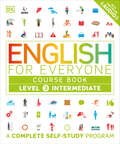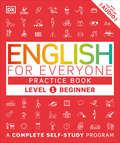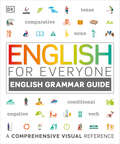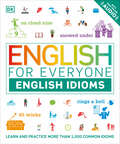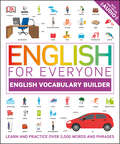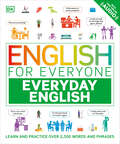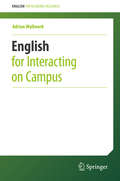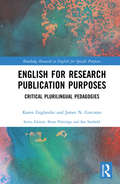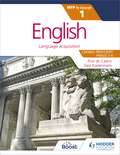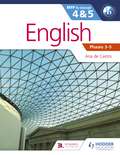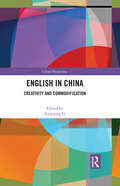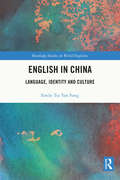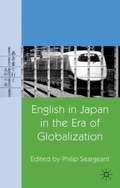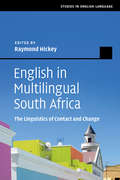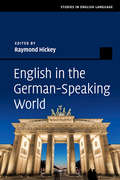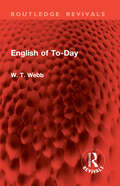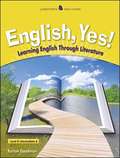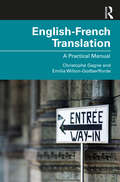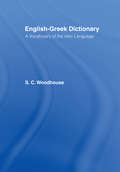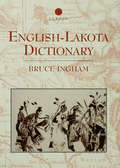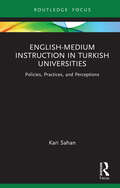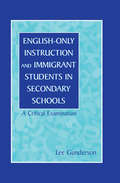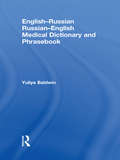- Table View
- List View
English for Everyone: A Complete Self-Study Program (DK English for Everyone)
by DKPLEASE NOTE - this is a replica of the print book and you will need paper and a pencil to complete the exercises.Take your self-study English language learning a step further with the third book in the easy-to-use, visual learning series.English for Everyone Level 3 Intermediate Course Book introduces topics such as telling a story, describing new experiences, relationships, and problem-solving. The step-by-step teaching methods are clear and engaging, making the English language easy to learn by yourself. Key language skills, grammar rules, and vocabulary are explained alongside colorful illustrations to help you put new language into context. Listening, speaking, reading, and writing exercises are set in bite-sized modules, allowing you to learn at your own pace.Free audio is available online to support your language learning, featuring native English speakers. The audio examples help you to build experience of spoken English and give you the chance to perfect your pronunciation.English for Everyone is aligned to the CEFR, the international standard for language learning, and ideal for preparation for major English-language exams including IELTS, TOEIC, and TOEFL. Whether you want to improve your English for work, study, or travel, the Level 3 Intermediate Course Book will make it incredibly easy to teach yourself English.
English for Everyone: A Complete Self-Study Program (DK English for Everyone)
by DKPLEASE NOTE - this is a replica of the print book and you will need paper and a pencil to complete the exercises.Practice makes perfect with this exciting guide to learning English.Work your way up with the ultimate self-study course that is easy to use and quick to learn. This practice book has a huge variety of bite-sized, attractively presented exercises to drill the language skills taught in English for Everyone Level 1 Beginner Practice Book. Hundreds of activities and accompanying audio cover listening, speaking, reading, and writing to reinforce language skills.You&’ll expand your English vocabulary with topics like introducing yourself, your job, and hobbies and interests. Get to grips with grammar rules, including using apostrophes and joining sentences, and perfect your pronunciation with audio exercises by native speakers. Eye-catching illustrations and step-by-step explanations keep content simple and straightforward for easy learning.Level 1 Beginner Practice Book is part of DK's best-selling English for Everyone series. It is suitable for all levels of English language learners and provides the perfect reading companion for study, exams, work, or travel. With audio material available on the accompanying website and Android/iOS app, there has never been a better time to learn English.
English for Everyone: A Comprehensive Visual Reference (DK English for Everyone)
by DKPuzzled by past tenses? Confused be comparatives? The English for Everyone Grammar Guide is packed with easy-to-follow English grammar rules and annotated sample sentences. Ideal for English test preparations or ESL lesson plans, the Grammar Guide uses visual teaching methods to introduce English grammar for beginners, reinforced through a variety of exercises and examples when used alongside our Grammar Practice Book. Once you have built up your confidence in the written English language, the Grammar Guide can act as a reference point for more advanced sentence structures in practical English usage.About English For EveryoneEnglish for Everyone is a series of guides and practice books that support English learning for teenagers and adults from a beginner level, to intermediate, and advanced practical English. Offering an easy-to-follow format that offers guidance for both teaching English as a foreign language, and a self-study approach with resources available to improve English speaking, reading, and writing.Whether you are looking for ESL teaching resources, or a structured program for adults to learn English as a second language, the English for Everyone Series provides:- Sample language examples: New language topics are introduced in context using clear, illustrated, and color-coded explanations- Supporting audio: Extensive English-speaking audio materials integrated into every unit, giving vital oral and listening practice. (All supplementary audio is available on the DK English for Everyone website and IOS/Android App).- Quick referencing: Easy-to-follow units, mirrored in both the Course and Practice Books for easy referencing and teaching- Sentence formation guides: Visual break downs of essential English grammar in use, showing learners how to recreate even complex English sentences- Visual English vocabulary cues: Lists of useful English words and common phrases with visual aids are available throughout the book- Personalised learning: Write-on lines encourage ESL learners to write their prompts and translations The English for Everyone Series covers the skills and topics required for all major global English-language exams and reference frameworks including:- CEFR- TOEFL - IELTS - TOEIC
English for Everyone: English Idioms (DK English for Everyone)
by DKAre you looking to brush up on your English idioms? English for Everyone: English Idioms can help you to understand the context and use of hundreds of native English expressions. Take your practical English usage to the next level and build your confidence in spoken and written English by visually connecting the literal and idiomatic meaning of common English phrases such as, &“on cloud nine&”, &“snowed under&”, and many more. With supporting audio available online, sample sentences throughout the book, collocations, and common mistakes to watch out for, English for Everyone: English Idioms can help you confidently progress your English language from advanced to fluent in both social and business environments. About English For EveryoneEnglish for Everyone is a series of guides and practice books that support English learning for teenagers and adults from a beginner level, to intermediate, and advanced practical English. Offering a fun and easy-to-follow format that offers guidance for both teaching English as a foreign language, and a self-study approach with resources available to improve English speaking, reading, and writing.Whether you are looking for ESL teaching resources, or a structured program for adults to learn English as a second language, the English for Everyone Series provides: - Sample language examples: New language topics are introduced in context using clear, illustrated, and color-coded explanations- Supporting audio: Extensive English-speaking audio materials integrated into every unit, giving vital oral and listening practice. (All supplementary audio is available on the DK English for Everyone website and IOS/Android App).- Quick referencing: Easy-to-follow units for easy referencing and teaching- Sentence formation guides: Visual break downs of essential English grammar for beginners, showing learners how to recreate even complex English sentences- Visual English vocabulary cues: Lists of useful English words and common phrases with visual aids are available throughout the bookThe English for Everyone Series covers the skills and topics required for all major global English-language exams and reference frameworks including:- CEFR- TOEFL- IELTS- TOEIC
English for Everyone: English Vocabulary Builder (DK English for Everyone)
by DKPLEASE NOTE - this is a replica of the print book and you will need paper and a pencil to complete the exercises.This absolutely essential language guide and workbook will expand your English vocabulary in no time.Spilling over with thousands of entries for useful words and phrases, this is the perfect study aid for any adult learning English as a foreign language. With 3,000 words across hundreds of pages, English Vocabulary Builder brings you everything you need to know and much, much more. From activities, family, holidays, science, and work to animals, feelings, health, sports, and weather, just about every subject in the English language is covered in eye-catching, illustrative detail. All the vocabulary is shown with both UK and US spellings, and every word can be heard with its own audio recording in the accompanying app available for download. Additional interactive exercises ensure language learning is an easy, entertaining, and educational experience. This book is part of DK's best-selling English for Everyone series, which is suitable for all levels of English language learners and provides the perfect reading companion for study, exams, work, or travel. With audio material available on the accompanying website and Android/iOS apps, there has never been a better time to learn English.
English for Everyone: Learn And Practice Over 1,500 Words And Phrases (DK English for Everyone)
by DKSpeak English with confidence in a wide range of everyday situations, from making small talk to booking a trip abroad. With more than 1,500 of the most useful phrases and common expressions, English for Everyone: Everyday English gives you all the English conversation skills you need to get by in the real world.This engaging and accessible book covers a wide range of real-life topics and scenarios - from everyday activities, such as going to the supermarket and making appointments, to key communication skills, such as comforting someone and dealing with conflict. You'll learn how to welcome visitors, ask for directions, give a presentation at work, find somewhere to live, order a meal out, and much, much more.Each short unit uses memorable, true-to-life dialogues to introduce a new topic, followed by practice exercises to reinforce the new words and phrases that you have learned. The dialogues are accompanied by attractive illustrations and brought to life by animated videos and audio featuring speakers of English as a first language, all available on the free English for Everyone website and app. Whether you need to learn English for work, study, travel, or relocation, English for Everyone: Everyday English is the perfect companion to help you take your English skills to the next level.
English for Interacting on Campus
by Adrian WallworkThis volume covers the day-to-day activities of a non-native English speaking student carrying out research, attending lectures, socializing, and living in a foreign country. Whether on a US campus as a foreign student, or in a non-English speaking country where classes are given in English, this book will help students build confidence in interacting with professors and fellow students.
English for Research Publication Purposes: Critical Plurilingual Pedagogies (Routledge Research in English for Specific Purposes)
by Karen Englander James N. CorcoranScholars who use English as an additional language confront challenges when disseminating their research in the global market of knowledge production dominated by English. English for Research Publication Purposes analyses the experiences and practices of these scholars across the globe and presents "critical plurilingual pedagogies" as a theoretically and empirically informed means of supporting them. This book: • Draws on an empirical study of a Latin American university’s effort to mount a course that provides support to emerging and established scholars who use English as an additional language; • Brings theoretically informed discussions of critical pedagogies, plurilingualism and identity affirmation to better serve plurilingual scholars who seek to publish their research in English-language journals; • Provides examples of classroom activities that can be adapted and adopted to local contexts and realities in a curriculum based on critical plurilingual pedagogies; • Proposes future directions for research into the internationally urgent, growing concerns of global scholars who produce English-medium academic knowledge for the world stage. Incisive and cutting-edge, English for Research Publication Purposes will be key reading for academics and upper-level students working in the areas of ESP, EAP, ERPP, and Applied Linguistics.
English for the IB MYP 1
by Zara Kaiserimam Ana de Castro Stephanie BarrusExam Board: MYPLevel: IBSubject: EnglishFirst Teaching: September 2016First Exam: June 2017Develop your skills to become an inquiring learner; ensure you navigate the MYP framework with confidence using a concept-driven and assessment-focused approach to English presented in global contexts.- Develop conceptual understanding with key MYP concepts and related concepts at the heart of each chapter.- Learn by asking questions with a statement of inquiry in each chapter. - Prepare for every aspect of assessment using support and tasks designed by experienced educators.- Understand how to extend your learning through research projects and interdisciplinary opportunities.
English for the IB MYP 1
by Zara Kaiserimam Ana de CastroExam Board: MYPLevel: IBSubject: EnglishFirst Teaching: September 2016First Exam: June 2017Develop your skills to become an inquiring learner; ensure you navigate the MYP framework with confidence using a concept-driven and assessment-focused approach to English presented in global contexts.- Develop conceptual understanding with key MYP concepts and related concepts at the heart of each chapter.- Learn by asking questions with a statement of inquiry in each chapter. - Prepare for every aspect of assessment using support and tasks designed by experienced educators.- Understand how to extend your learning through research projects and interdisciplinary opportunities.
English for the IB MYP 4 & 5: MYP by Concept (MYP By Concept)
by Ana de CastroWe are working with the IBO to gain endorsement for the MYP by Concept series.Drive meaningful inquiry for the new framework through a unique concept driven narrative.- Supports every aspect of assessment with opportunities that use the criteria- Gives you easy ways to differentiate and extend learning- Provides a meaningful approach by integrating the inquiry statement in a global context- Develops critical-thinking skills with activities and summative sections rooted in the ATL frameworkAlso coming soon are Teaching and Learning Resources and eTextbooks via Dynamic Learning, our complete digital solution.
English for the IB MYP 4 & 5: MYP by Concept (MYP By Concept)
by Ana de CastroWe are working with the IBO to gain endorsement for the MYP by Concept series.Drive meaningful inquiry for the new framework through a unique concept driven narrative.- Supports every aspect of assessment with opportunities that use the criteria- Gives you easy ways to differentiate and extend learning- Provides a meaningful approach by integrating the inquiry statement in a global context- Develops critical-thinking skills with activities and summative sections rooted in the ATL frameworkAlso coming soon are Teaching and Learning Resources and eTextbooks via Dynamic Learning, our complete digital solution.
English in China: Creativity and Commodification (China Perspectives)
by Songqing LiEnglish-related linguistic creativity and language commodification are a constant topic of interest and analysis for scholars. This volume is intended to initiate a dialogue between these two domains of inquiry that have been abundantly addressed but rarely documented together or in relation to one another. English as used in mainland China is presented as a case study where it remains rather unclear the extent to which the language is actually used in people’s lives, outside the domain of education. The volume enriches existing empirical studies by exploring the creative and innovative uses of English in people’s lives and its commodification at different language-centred economic spaces within China while also providing an update of our understanding of the sociolinguistic situation of English in China, a country undergoing rapid socio-economic transformation. English in China is the first attempt to discuss the possible relationship, intersection, and tension between two seemingly inseparable research topics. The book is an important resource for students and scholars in the fields of Applied Linguistics, Bilingualism, Sociolinguistics, Translation, and Contemporary Chinese Studies.
English in China: Language, Identity and Culture (Routledge Studies in World Englishes)
by Emily Tsz FongThis volume explores Chinese identity through the lens of both the Chinese and English languages. Until the twentieth century, English was a language associated with capitalists and "military aggressors" in China. However, the massive progression of globalisation in China following the 1980s has transformed the language into an important tool for China’s modernisation. Regardless of the role English plays in China, there has always been a fear there that the spread of culture(s) associated with English would lead to weakening of the Chinese identity. This fear resulted in the development of the ti-yong principle: "Chinese learning for essence (ti), Western learning for utility (yong)." Fong’s book aims to enhance understanding of the ti-yong dichotomy in relation to people’s sense of being Chinese in China, the penetration of English into non-English speaking societies, the resultant tensions in people’s sense of personal and national identity, and their place in the world. Using Q methodology, the book presents observations based on data collected from four participant groups, namely high school and university students, teachers and parents in China, to investigate their perspectives on the status and roles of English, as well as those of Chinese. Considering the growing international interest in China, this volume will appeal to readers interested in China’s contemporary society in general, its language, culture and identity. It will be a useful resource for academics, researchers and students in the field of applied linguistics, language education and Chinese cultural studies and can also be adopted as a reference book for undergraduate courses relating to language, identity and culture.
English in Japan in the Era of Globalization
by Philip SeargeantLeading scholars in the field examine the role played by the English language in contemporary Japanese society. Their various chapters cover the nature, status, and function of English in Japan, focusing on the ways in which globalization is influencing language practices in the country.
English in Multilingual South Africa: The Linguistics of Contact and Change (Studies in English Language)
by Raymond HickeySouth Africa is a country characterised by great linguistic diversity. Large indigenous languages, such as isiZulu and isiXhosa, are spoken by many millions of people, as well as the languages with European roots, such as Afrikaans and English, which are spoken by several millions and used by many more in daily life. This situation provides a plethora of contact scenarios, all of which have resulted in language variation and change, and which forms the main focus of this insightful volume. Written by a team of leading scholars, it investigates a range of sociolinguistic factors and the challenges that South Africans face as a result of multilingualism and globalisation in both education and social interaction. The historical background to English in South Africa provides a framework within which the interfaces with other languages spoken in the country are scrutinised, whilst highlighting processes of contact, bilingualism, code-switching and language shift.
English in the German-Speaking World (Studies in English Language)
by Raymond HickeyEnglish has a considerable history in Germany, Austria and Switzerland, and present-day English has a significant influence on the vocabulary of modern German. Examining the ongoing influence of English on German in these countries, Raymond Hickey leads a team of authors to explore a wide range of topics, such as the history of English teaching in Germany, the type of English spoken in German-speaking countries today, and the role of English in German society. Borrowings from English in present-day German, as well as the use of English in public places, is also discussed, as is the use of English by non-Germans living in Germany, and the situation of Germany as a country with English as a foreign language. Comparisons with other European countries are also analysed, and a consideration of the German-English interface in places as far apart as the United States and Namibia, is also presented.
English of To-Day (Routledge Revivals)
by W. T. WebbFirst published in 1925, English of To-Day deals effectively with the many common errors in the use of English and gives examples of good and bad writing from almost every department of literature. The title English of To-Day has been adopted because the errors in the use of English with which it deals are, many of them, comparatively modern.Numerous instances of such errors have been given, partly to emphasise their existence and partly to furnish teachers of English with useful exercises for their pupils in the correction of mistakes in grammar and composition. A very full index has been appended, so as to provide the reader with a corrective to somewhat discursive character of the subject matter. This useful and amusing little manual will be of interest to English teachers and general readers.
English, Yes!: Intermediate A
by Glencoe Mcgraw-HillEnglish, Yes! uses multicultural literature as the foundation for improving comprehension, vocabulary, grammar, and writing. Adapted selections from classic and contemporary authors of many cultures engage students in learning English.
English-French Translation: A Practical Manual
by Emilia Wilton-Godberfforde Christophe GagneEnglish-French Translation: A Practical Manual allows advanced learners of French to develop their translation and writing skills. This book provides a deeper understanding of French grammatical structures, the nuances of different styles and registers and helps increase knowledge of vocabulary and idiomatic language. The manual provides a wealth of practical tasks based around carefully selected extracts from the diverse text types students are likely to encounter, from literary and expository, to persuasive and journalistic. A mix of shorter targeted activities and lengthier translation pieces guides learners through the complexities and challenges of translation from English into French. This comprehensive manual is ideal for advanced undergraduate and postgraduate students in French language and translation.
English-Greek Dictionary: With a Supplement of Proper Names Including Greek Equivalents for Famous Names in Roman History
by S. C. WoodhouseFirst published in 1998. Routledge is an imprint of Taylor & Francis, an informa company.
English-Lakota Dictionary
by Bruce InghamThis dictionary of 12,000 entries aims to preserve Indian culture and at all points illustrate the use of words in examples, especially syntactic words, whose usage cannot be captured purely by giving an English equivalent. It provides depth as regards the usage of frequently occurring items and especially in the use of syntactic elements and usage in context.
English-Medium Instruction in Turkish Universities: Policies, Practices, and Perceptions (Routledge Focus on English-Medium Instruction in Higher Education)
by Kari SahanIn response to the growing use of English as an international language, the number of English-medium instruction (EMI) programs in higher education has increased. However, decisions to implement EMI programs are often made through top-down policymaking processes with little consideration for the educational issues surrounding language policy changes.This book examines the variation with which EMI is implemented at universities in Turkey through a multilevel empirical investigation of policies, practices, and perceptions. In addition to providing a sociohistorical overview of EMI in Turkey, the book draws on a dataset that includes policy documents, classroom observations, interviews with teachers, and focus group discussions with students. Despite national policies which envision a "one-language-at-a-time" model of EMI education, this book argues that EMI is neither English-only nor English-always in practice. By highlighting the variation with which EMI is implemented at and across Turkish universities, this study illustrates the need for more comprehensive EMI policies and processes aimed at integrating content and language learning in higher education.Implications are discussed with respect to policy planning, program development, and pedagogical support and will be relevant for researchers and postgraduate research students interested in EMI, particularly in the Turkish context.
English-Only Instruction and Immigrant Students in Secondary Schools: A Critical Examination
by Lee GundersonThis book is for teachers, teacher educators, school and district administrators, policy makers, and researchers who want to know about literacy, cultural diversity, and students who speak little or no English. It offers a rich picture of the incredible diversity of students who enter secondary school as immigrants—their abilities, their needs, and their aspirations. The studies reported are part of a large longitudinal study of about 25,000 immigrant students in a district in which the policy is English-only instruction. These studies:*provide multiple views of the students’ lives and their success in schools where the language of instruction differs from the languages they speak with their friends and families;*explore the students’ views of teaching and learning; *describe the potential differences between the students views and those of their teachers; *look at issues related to students’ views of their identities as they work, study, and socialize in a new environment; and*examine different reading models designed to facilitate the learning of English as a second language (ESL). Educators and researchers will find the descriptions of students’ simultaneous learning of English and of academic content relevant to their view of whether instruction should be English only or bilingual. For teachers who view multicultural education as an important endeavor, this book may on occasion surprise them and at other times confirm their views. The author does not attempt to develop a particular political viewpoint about which approach works best with immigrant students. Rather, the objective of the studies was to develop a full, rich description of the lives of immigrant high school students enrolled in classes where the medium of instruction is English. The reader is left to evaluate the results.
English-Russian Russian-English Medical Dictionary and Phrasebook
by Yuliya BaldwinFirst Published in 2012. Routledge is an imprint of Taylor & Francis, an informa company.
